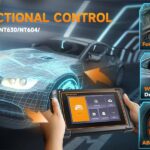Navigating the world of car diagnostics can be confusing, especially when dealing with older models. If you own a 1998 Nissan Patrol, you might be wondering about its On-Board Diagnostics (OBD) protocol. Specifically, is a 1998 Nissan Patrol Obd2 compliant? This article delves into the diagnostic systems used in Nissan Patrols, focusing on the 1998 model and helping you understand how to diagnose your vehicle effectively.
To understand the diagnostic capabilities of a 1998 Nissan Patrol, we first need to differentiate between OBD2 and Nissan’s proprietary Consult system. OBD2 (On-Board Diagnostics II) is a standardized system introduced in the mid-1990s, becoming mandatory in the US in 1996 and later adopted in other markets. It uses a standardized 16-pin Diagnostic Link Connector (DLC) and a set of standardized diagnostic trouble codes (DTCs).
However, Nissan, like many manufacturers, had its own diagnostic system before OBD2 became the standard. This system is known as Nissan Consult. Early Consult systems used a proprietary connector, typically a 14-pin plug, and required specific Nissan Consult scan tools. Later versions, like Consult II, sometimes used the OBD2 style 16-pin connector but still communicated using the Consult protocol, not the standard OBD2 protocols.
So, what does this mean for your 1998 Nissan Patrol? Based on discussions among Nissan Patrol owners, it’s highly likely that a 1998 Nissan Patrol, particularly the GU series with the TB45E engine, primarily uses the Nissan Consult diagnostic system. While some models around this period might have been equipped with an OBD2-style 16-pin connector, it doesn’t automatically mean they are fully OBD2 compliant in terms of protocol.
Understanding the Nissan Patrol OBD Plug: This image illustrates the diagnostic plug commonly found in Nissan Patrol models around 1998, crucial for identifying the compatible diagnostic system.
Owners in forums have reported that early GU Patrols, including those around 1998, often utilize the Consult system. They mention using tools and software compatible with Nissan Consult for diagnostics. This means that a generic OBD2 scanner might not fully communicate with your 1998 Nissan Patrol’s computer systems. It might connect physically if a 16-pin plug is present, but it likely won’t be able to retrieve the full range of diagnostic data or error codes because it’s “talking” OBD2 while the car “speaks” Consult.
For diagnosing a 1998 Nissan Patrol, especially models like the TB45E Y61, it’s recommended to focus on tools and software that support the Nissan Consult protocol. Software like Nissan DataScan (NDSII) is frequently mentioned by Patrol owners as being effective for reading data and diagnosing issues on these models. These programs, often used with interfaces like a Blatz cable or specific Bluetooth adapters designed for Consult, can provide access to ECU data.
Keep in mind that even if your 1998 Patrol has a 16-pin connector, it could still be running the Consult protocol, potentially Consult I or a later version. Some owners have noted that even with the 16-pin OBDII style plug, their vehicles were still using Consult II. Therefore, simply seeing a 16-pin plug does not guarantee OBD2 compliance for a 1998 Nissan Patrol.
In conclusion, while some later Nissan Patrols transitioned to OBD2, a 1998 Nissan Patrol is more likely to use the Nissan Consult diagnostic system. To properly diagnose your 1998 Nissan Patrol, especially if it’s a GU model with a TB45E engine, you should investigate diagnostic tools and software specifically designed for Nissan Consult. Look for compatibility with Consult I or Consult II, and be prepared to use adapters that may be specific to the Nissan Consult protocol rather than relying solely on generic OBD2 scanners. Checking your vehicle’s service manual or consulting a Nissan specialist can further clarify the exact diagnostic protocol and connector type for your specific 1998 Nissan Patrol model.
